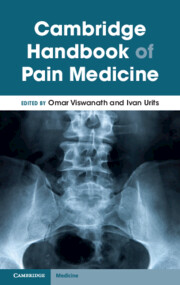Book contents
- Cambridge Handbook of Pain Medicine
- Cambridge Handbook of Pain Medicine
- Copyright page
- Contents
- Contributors
- Pain Handbook Introduction
- Part I Introduction to Pain: Pain Signaling Pathways
- Part II Common Categories of Pharmacologic Medications to Treat Chronic Pain
- Part III Chronic Pain Conditions Head and Neck
- Part IV Spine
- Part V Extremities
- Part VI Misc
- Chapter 26 Post-herpetic Neuralgia (PHN)
- Chapter 27 Complex Regional Pain Syndrome (CRPS)
- Chapter 28 Sickle Cell Disease
- Chapter 29 Breast Pain
- Chapter 30 Post-thoracotomy Pain
- Chapter 31 Multiple Sclerosis Pain
- Chapter 32 Cerebral Palsy
- Chapter 33 Myofascial Pain Syndrome
- Chapter 34 Post-stroke Pain
- Chapter 35 Chronic Abdominal Pain
- Chapter 36 Chronic Pelvic Pain
- Chapter 37 Postsurgical Nerve Entrapment
- Chapter 38 Cancer Pain
- Part VII Adjunctive Therapy
- Index
- References
Chapter 27 - Complex Regional Pain Syndrome (CRPS)
from Part VI - Misc
Published online by Cambridge University Press: 01 December 2023
- Cambridge Handbook of Pain Medicine
- Cambridge Handbook of Pain Medicine
- Copyright page
- Contents
- Contributors
- Pain Handbook Introduction
- Part I Introduction to Pain: Pain Signaling Pathways
- Part II Common Categories of Pharmacologic Medications to Treat Chronic Pain
- Part III Chronic Pain Conditions Head and Neck
- Part IV Spine
- Part V Extremities
- Part VI Misc
- Chapter 26 Post-herpetic Neuralgia (PHN)
- Chapter 27 Complex Regional Pain Syndrome (CRPS)
- Chapter 28 Sickle Cell Disease
- Chapter 29 Breast Pain
- Chapter 30 Post-thoracotomy Pain
- Chapter 31 Multiple Sclerosis Pain
- Chapter 32 Cerebral Palsy
- Chapter 33 Myofascial Pain Syndrome
- Chapter 34 Post-stroke Pain
- Chapter 35 Chronic Abdominal Pain
- Chapter 36 Chronic Pelvic Pain
- Chapter 37 Postsurgical Nerve Entrapment
- Chapter 38 Cancer Pain
- Part VII Adjunctive Therapy
- Index
- References
Summary
Complex regional pain syndrome (CRPS) is a long-term pain condition that commonly affects the extremities and is associated with increased sensitivity to pain and touch. CRPS is classified into two types: CRPS-I and CRPS-II. The former occurs when there is no apparent nerve damage, whereas the latter is linked to known nerve damage. Psychological factors may play a role in the development of CRPS, with studies indicating that individuals with a history of depression and PTSD are at a higher risk of developing this condition. There are various treatment options available for CRPS, including physical therapy, medication, and interventional techniques such as nerve blocks and transcranial stimulation. However, larger and more comprehensive studies are needed to assess the effectiveness of these therapies. While NSAIDs have not been found to be effective in treating CRPS, sympathetic nerve blocks are commonly used but have mixed results. Finally, spinal cord stimulation (SCS) is a surgical treatment option that is recommended after conservative treatments have failed to produce significant symptom relief over several months.
- Type
- Chapter
- Information
- Cambridge Handbook of Pain Medicine , pp. 220 - 227Publisher: Cambridge University PressPrint publication year: 2023



